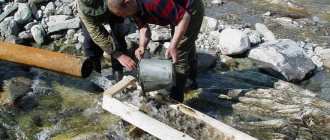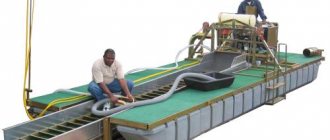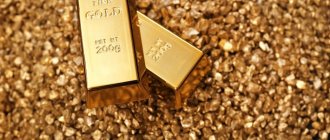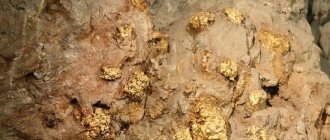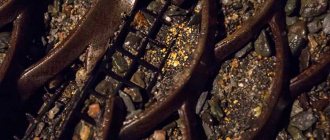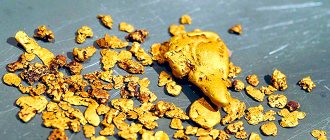Man has become so accustomed to constant changes and new technologies that he has stopped paying attention to familiar things.
The wheel, fire, fabric, stone, metal, even plastic have become something commonplace and everyday for us.
However, there is one eternal material that has not lost its relevance: gold has been and remains a measure of value and a driver of progress.
Where did this amazing metal come from, without which our banking system does not exist and space flights cannot be imagined?
Why is everything that is around in one way or another connected with gold?
Introducing a Man to Gold
Gold chips obtained by sifting gold-bearing sand
The first known written references to the use of gold in this meaning date back to the Egyptian records of the Menes dynasty in 3100 BC, and gold religious objects are found during excavations of the Sumerian city-states, at the site of Mohenjo-Daro.
Many of the oldest sources claim that gold came to them from the cradle of humanity - the African territories that today contain Sudan, Ethiopia, Somalia, Zimbabwe and possibly Rwanda.
Unfortunately, the rarity of gold has left it a cult material - otherwise, instead of the “Copper Age”, we would know the historical “Golden Age”, which would have come much earlier.
Preserved mask of the Inca Empire
However, the civilizations of Central and South America were able to combine the cult and industrial significance of gold, making from it not only amulets and coins, but also many more prosaic things - for example, the well-known “tiles” with which the Indians paid Pizarro’s ransom for the Great Inca.
Unfortunately, New World artifacts were melted down into ingots . They could not only talk about the use of gold, but also suggest how ancient Europeans, who also lost ancient things made of precious metals in processing, could have used it.
Camel, 9 kg
He was found in Kolyma back in 1947. It weighs over 9 kg (9 kg 288g). It received this name due to its shape, which really resembles the body and head of a dromedary camel.
It has a shell-like surface and is heavily rounded, from which experts concluded that the “ Camel ” had been in the river bed for a long time, with river pebbles wrapped around it on all sides, giving it such an unusual shape.
Unique properties of gold that we will still need
Mercury still helps in gold mining today
In addition to malleability and ductility, gold quickly showed its other wonderful properties. One of them is the ability to create the thinnest films, which are called “gold leaf”.
They are produced by long-term rolling, forging, or applying a melt of gold with mercury - an amalgam. The result is sheets up to ~0.1 μm (100 nm) thick. If desired, you can create the thinnest but strong wire threads.
In addition, for a long time it was believed that gold could not be dissolved with acid. At least pure: of pure acids, gold can only be treated with selenium acid, but traditionally they use aqua regia.
Gold sand
Unique physical properties and rare but unique production from gold-bearing waters (the most ancient mining was alluvial) or nuggets gave humanity a reason to consider gold “the metal of the gods.”
Even the notorious “Golden Fleece” is nothing more than sheep skins spread in rivers to obtain particles of gold. After a long period of washing, they were burned and small gold bars were obtained.
Where did ancient people think gold came from? The gift of the underground gods, their ceremonial things and the rays of the sun itself.
Diamond producing countries
Since each diamond is unique in its kind, it is customary to separate their accounting among world countries according to production volumes and in value terms. The bulk of diamond production is distributed among only nine countries. These are Russia, the Republic of Congo, Botswana, Australia, Canada, Angola, South Africa, Zimbabwe and Namibia.
In value terms, the leaders among these countries are Russia, African Botswana and Canada. Their total diamond production accounts for more than 60% of the value of the world's mined diamonds.
For incomplete 2021 (according to the latest data), Russia takes first place in terms of production volumes and value. Its share in value terms accounts for about 40% of total world production. This leadership has belonged to Russia for several years.
Gold appeared in the explosions of stars. But you can do it yourself
Unrefined gold nugget. Such people have been found, are being found, and will continue to be found.
The subsequent development of science, especially nuclear physics and materials science, forced scientists to think seriously: where do certain compounds and elements of the Periodic Table come from in nature?
Gold is present not only in deposits. It is dispersed throughout the planet, and is present in small proportions even in animals and people themselves.
According to some estimates, the ocean contains 20 million tons of gold dissolved in water, but in such low concentrations that the process of extracting it at this stage is too expensive.
It has long been assumed that gold was present in the original composition of the Earth before the formation of the earth's crust, and that the volcanic activity of the planet caused it to partially “rise” to the surface in the form of deposits.
Gold-bearing vein. Even primitive technology can extract metal from such a material.
This theory is partly explained by the presence of the element in post-igneous rocks. In addition, most primary deposits have large metal inclusions and are located in the form of gold-bearing veins.
However, large amounts of gold are dispersed in solid rocks in atomic form. In addition, planets are formed from gas and dust clouds and contain only some heavy elements in very small quantities.
As modern data show, to obtain gold, a nuclear reaction with high neutron radiation is necessary. This is the only way, through a long chain of transformations, to obtain radioactive gold.
A supernova was once considered the origin of gold
But the spectral lines of the Sun contain inclusions corresponding to gold. Therefore, it is there and could get to Earth with the solar wind.
If you didn't get there before. The solar wind would not provide an even distribution of the element. These contradictions and advances in astrophysics led to the emergence of a theory about the creation of gold during supernova explosions.
And only in 2013, scientists from the Harvard-Smithsonian Center for Astrophysics in Cambridge managed to detect traces of gold when analyzing a gamma-ray burst recorded at a distance of about 4 billion light years from Earth.
The gamma-ray burst was associated with the collision of two neutron stars and the subsequent explosion. It was this super explosion that gave birth to gold weighing several of our moons, as well as other heavy metals.
It was after such an event that gold came to us
Probably, a similar stream of particles visited the Earth about 540 million years ago and even earlier, leaving the first gold-bearing rocks.
Gradually, scattered atoms under the influence of geological processes formed modern gold veins, which all of humanity is familiar with from dozens of works describing the “gold rush”.
The story of the first gold nugget in Rus'. The phenomenon of the "gold rush" of the mid-19th century
Despite the fact that gold products in Rus' began to be made since ancient times, imported noble metal was used. The fact that the Russian land is rich in gold deposits was known from ancient historical sources. Finished gold items were found at the settlement sites of the ancient Slavs. 1745 is the year when native gold was discovered in the Urals, and two years later the first mine, the Initial mine, was opened on this site.
The 19th century is known for the beginning of the so-called gold rush in Alaska. Dreaming of fabulous wealth, prospectors left their homes and risked their lives.
The gold rush also did not spare Russia. Since the beginning of the 19th century, prospectors tried to conquer Siberia and the Far East, Kuzbass and Tom.
There is gold in everything, even in us. But just a little
Gold is almost always mined where there is water: it is washed out of the ores
Bombardment from space was a success: today gold can be found everywhere, although it is very small as a percentage of the total mass of the planet.
So, in a cubic meter of water there is at least 5 milligrams of this metal. Primary gold ores contain at least 25-40% of the element , which is very high compared to other industrial metals.
In addition, the native form of both relatively pure gold and its natural alloy with silver, electrum, is common.
Another form of native gold: “grains”
Often, nuggets are found in secondary bulk deposits that appeared as a result of the destruction of primary gold-bearing rocks.
Other, lighter minerals leave the area under the influence of wind or water, increasing the concentration of gold in a certain area.
Thanks to such deposits, humanity began to mine gold industrially 3,000 years ago. At the same time, the first jewelry found in the tombs of ancient Egypt and Sumer, the cradles of human civilization, dates back.
Modern gold hunters are little different from their counterparts a thousand or two ago
Today, about 166.6 thousand tons of gold . Every year this figure increases by almost 3 thousand tons, and the figure is growing steadily.
Less than structural metals such as iron or nickel. But almost 30% of the precious metal in the past was obtained from native and alluvial forms, which is impossible for others.
Why is the metal often confused with pyrite? What geologists say about gold nuggets
With the onset of the gold rush, ships filled with pyrite sailed from America to Europe. Due to its external resemblance, this breed was often confused with gold. In fact, pyrite is iron pyrite, also called fool's gold or the stone of madmen. Gold and pyrite can be distinguished by several characteristics:
- Form. Pyrite is a crystal-shaped stone with sharp edges; gold has soft, rounded edges.
- Smell. Pyrite contains more than 50% sulfur, so it has a specific rotten smell. Noble metal has no odors.
- Size. Pyrites can occur in different sizes. Gold is more often found in bulk, less often in small pieces, and even less often in large ingots.
- Hardness. Noble metal is very soft and malleable, so a ligature is used to make jewelry or other products. A gold bar can easily be pierced with a needle and can be tasted on the tooth. Pyrite is hard.
Gold nuggets
Pyrite and gold are similar in color, brilliance, and density.
Geologists studied the similarities between the two rocks:
- A. Betekhtin “Pyrite group. Mineralogy Course";
- K. Gurlitt “Manual Mineralogy”;
- A. Smolin “Golden nuggets of the Urals”.
Only centuries later, pyrite ceased to be known as a deceiving stone, and people learned to use its beneficial properties.
Gold mining has remained unchanged for thousands of years. But there are options
Plant for the chemical production of gold from ores
In the past, gold was mainly mined by panning , a modified ancient method. Previously, this was done in gold-bearing rivers, collecting sand and washing it under the pressure of water.
Today, gold-bearing ore is raised to the surface, crushed (carefully so as not to see the nuggets) and processed in a stream of water. Minerals with a density less than gold (which is almost all the minerals in the earth's crust) are washed away, and the metal is concentrated in a heavy fraction of sand called concentrate.
A dredge that industrially washes gold-bearing sand
In addition, chemical methods for obtaining gold from minerals with low element content have become widespread. It is also suitable for tightly bound particles of basic gold.
Amalgamation has been known since the 1st century BC thanks to work in the deposits of modern Spain. This method involves mixing gold-bearing rock with mercury, collecting the amalgam and then separating the metals.
In Africa, gold is still mined using mercury today. With bare hands
Cyanidation involves dissolving gold from rocks using hydrocyanic acid, air and water. It has limited use and produces metal with many impurities, but in some cases there is no alternative.
Regeneration is carried out by the action of a 10% alkali solution on solutions of gold salts, followed by precipitation of refined gold onto aluminum from a hot solution. Complex and expensive method.
How can you mine Au?
To do this you will need the following equipment:
- The tray is better if it is blue: against this background, the yellow grains become especially noticeable.
- The gateway is the second stage of treatment from sand and other impurities, as it has special inserts on which heavier Au settles, and everything else is washed out.
- Tools – gold is mined in cracks using a pick or pick.
- Miniature gold dredge. Lightweight portable floating gold mining equipment. A budget option that makes it easier to search for aurum in rivers, it passes through up to 10 cubic meters of water per hour. With its help, panning for gold will be easier.
Without gold there is no economy, gadgets and tanks
The gold standard was abolished. But the role of gold in the economy has increased
Everyone knows that jewelry is made from gold with the addition of other metals (pure gold is too soft to hold its shape), and that savings can be invested in its “virtual bars”.
Many people know that gold was the basis of the world's banking system until the transition to a single conventional unit was made - the dollar, in which today the main mutual settlements are made in the international arena.
But the main importance of gold in the 20th and 21st centuries often escapes attention. Gold is an excellent conductor, resistant to most oxidizing agents, and therefore does not lose its electrical properties.
Gold-plated radio components were previously used in military equipment. Now - in all high-precision
Therefore, contacts for especially critical devices were made and continue to be made from it. They cover boards, connectors, and even add them to wires to ensure their operation.
Experts estimate that the iPhone contains about 30 mg of gold, most of which is found in the contact pads of the circuit boards. And this number has not changed for many years.
More importantly, gold is used as targets in the manufacture of various radiation sources: on them, accelerated particles abruptly stop for the subsequent production of others sought in the experiment.
Contrary to the sneers around audiophiles, in a number of schemes there is no alternative to gold: it can only be replaced by more expensive and difficult to process rare earth metals, such as palladium, iridium, and platinum.
Most often, extracting gold from devices is not difficult, but tedious. But almost chemically pure
Silver is not so easy to solder and is much more sensitive to aggressive environments. It also has certain electrochemical properties that do not allow the use of “Argentum” in high-precision technology due to changes in the parameters of the material.
The conventional Record tube TV from the last century contained up to 100 milligrams of gold and about 2.5 grams of silver. More accurate military equipment or professional measuring instruments - even more.
How to find a treasure? Modern metal detecting for beginners
Treasure hunting is an exciting pastime that consists of outdoor activities, studying the history of the country and the places where you were born, working with maps from different years, knowledge of geography, studying various artifacts and many other components of this exciting hobby.
Disclaimer (important warning): It is necessary to study and comply with Law No. 245-FZ of July 23, 2013 “On amendments to certain legislative acts of the Russian Federation regarding the suppression of illegal activities in the field of archeology.” The law does not prohibit the use, purchase, or sale of metal detectors and does not require a special license. The ban on use is established only in relation to archaeological monuments.
Content
- Equipment Metal detector
- Pinpointer
- Transport
- Accessories
- Seasons to search
Equipment
Metal detector
The first thing you need to join the ranks of modern treasure hunters is a metal detector. You shouldn’t immediately look at the expensive models of these devices. It is unlikely that at first you will need all the numerous functions and capabilities that professional detectors have. Therefore, it is better to buy an inexpensive device first.
For example, the most popular model for searching among amateurs is the Garrett Ace 250 metal detector. This model is one of the best for a beginning treasure hunter. The Garrett ACE 250 is positioned as a lightweight metal detector for beginners, but with features that are often found only in more expensive detectors. The ACE 250 is one of the best-selling Garretts worldwide of all time. It can be used to install replaceable coils of other sizes when searching in fields or house foundations. The larger the coil, the greater the depth it detects the target, but with less accuracy. There is no need to chase a larger diameter; you must first learn how to work with a complete universal reel.
Pinpointer
Both the novice treasure hunter and the experienced one need one more device: a pinpointer. This is a small metal detector, without metal discrimination, with a short range to make it easier to find finds in a hole or dump after a large metal detector.
Pros of working as a pinpointer:
- Save time. The faster you find a dug-up target in a dump, the more territory you can cover. After all, sowing soil by hand is an inconvenient task, sometimes taking a long time (if you come across a pellet, a flake, etc.).
- Saving energy. When the target is somewhere in a hole, as a rule, you begin to expand and deepen it, trying to throw out the find along with the earth. Using a pinpointer, you can localize a target in a hole without digging too much and then, after making just one “dig,” throw the find out.
- Search in the dark. Basically, pinpointers are equipped with an external LED and you can easily find an object on dark ground. Also, the backlight is very useful when searching in an abandoned building, in the basement.
I talked about the modern 2nd generation Shrxy pinpointer. Review
Transport
How many years have metal detectors been common in our country? — About 25-30 years old. During this time, all interesting places for finds have already been “knocked out”, only hard-to-reach ones remain.
Accessibility can be roughly shown as follows: Where you can get there by car -> SUV -> ATV -> on foot.
Transport for digging trips must be selected according to the location, but your legs will never let you down.
Accessories
- Shovels for a cop. Fiskars understands this matter.
- Headphones to the detector. Using headphones allows you to distinguish quiet signals, protects against the influence of extraneous noise, and extends battery life.
- Backpacks for carrying equipment and personal items.
- Lost and found bags. For example, on a belt.
- Scoops for cleaning dug holes and when working on house foundations.
- Scoops (sifter scoop) for searching on beaches.
- Headlamp, when searching in attics, basements and in the dark.
- A small folding saw for cutting and removing roots when digging under small trees and shrubs.
- Gloves are necessary to protect your hands from cuts.
- Insect protection products (repellents).
- Unloading. Comfortable clothes for treasure hunters, allowing you to evenly arrange the necessary and important items when searching
- Knife. This is one of the important tools of a tourist destination and is a necessary tool for a treasure hunter. Experience shows that sometimes it is thanks to the presence of a knife that it is possible to carefully dig up something really valuable, and if you have to spend the night or move through a wooded area, it is generally difficult to imagine life without a knife, even the simplest one.
Also, during long field trips to dig, the treasure hunter’s body wants to eat after just a couple of hours. It’s natural to work with a shovel in the fresh air.
In order not to be distracted by cooking outdoors, I recommend using ready-made food kits. And these are not only instant noodles, but more satisfying sets, for example, ★ Army IRP. It's enough for one adult for one day!
Another tip. If you are going completely into the wilderness (abandoned tracts in the forests), you need to take something to scare away wild animals. For example: hunter's signal.
Animals are less friendly than this:
Search locations and times
Currently, there are a lot of extinct and abandoned villages that exist in any area. Take old maps, compare them with modern maps and conduct searches.
Old abandoned villages are shops, baths, clubs, schools, dance floors, recreation areas and of course houses and foundations. In cities there are beaches, forest parks, places for sports and competitions. Very old villages have long been plowed over. Plowed fields are searchers' favorite places. Here the principle of the search is this: to search where people lived, there will definitely be finds.
I especially want to note the places of inns (visiting) yards in the Russian Empire, which were located along large highways (highways) 10-15 km from each other. This is a type of inexpensive hotel - accommodation for the night with a yard to accommodate horses and carriages. At the court there was a forge for repairing carriages, horses were shoed, and if necessary, they were replaced. The inn usually also had a tavern.
Seasons to search
Spring. Plowed fields, the ground is thawed, wet, there is no grass, the detection depth of the device will be a little greater. In spring they dig where they cannot dig in summer: fields, vegetable gardens, forest clearings.
Summer. Digging along old forest roads preserved in their original form, dry crossings, digging foundations, searching for mortgaged coins under the crowns of houses.
Autumn. We dig mainly in plowed and harvested fields. A little grass will help us again.
Winter. If the winter is not frosty and there is little snow, we continue to dig in our favorite places. We examine old abandoned houses and attics and basements. We are also looking for mortgaged coins under the crowns of log houses.
Nakhodki
The first thing you always come across are nails, wire, plugs. Almost always you come across: various old buttons, crosses, icons, icons, sometimes badges, medals, parts from samovars, bells, “horse meat” (horse harness items) and much more.
Examples of antique finds by category:
Colleagues in the hobby beautifully decorate ancient finds in panels:
About treasures
Ordinary people hid treasures in cellars, attics, gardens, and forests. But where was he hiding in the house? Namely: in window sills, in stoves, in door frames, and also in wells. If they hid in the garden, then a certain number of steps were counted from some landmark, a hole was dug and savings were placed there, in cellars they were usually hidden in one corner in the floor or wall; if we take a well, then they were hidden as at the bottom of a well , and in the wall, and this could be a log house or a stone.
Thieves and robbers hid treasures where they robbed, in the depths of forests and fields away from human eyes, near bridges and crossings. The loot could be in the form of dishes, gold jewelry and coins. Usually such treasures were hidden in holes that were more than a meter deep, under boulders, in tree hollows. Places such as swamps and ponds were also used. The landmarks were old trees, large stones, boulders, and ravines.
Owners of mills and taverns usually hid their fortune in fields, buildings (be it a mill, tavern, tavern, etc.), and also in the walls of basements.
Military treasures. In such places, soldiers hid their savings and valuable items before the battle. They hid it so that the enemy or the enemy would not get the goods, they usually did it near the location of the troops, finding nearby a large tree, rock, stone, or something else that would be in the target landmark. Found war treasures may consist of coins and valuable items.
Conclusion
The work of a digger is difficult and requires patience, perseverance and love for your hobby. But fortune favors the brave. Finding a treasure is quite possible.
Thank you for your attention! Interesting finds!
Instead of a finale: gold is needed even in space
Israeli satellite covered with gold foil for thermal insulation
Of course, now precious metals are not used in such quantities in household appliances, but every year at least 10% of the total production (approximately 300 tons in 2014) is used for the manufacture of industrial products.
As a result, gold recycling reaches at least a quarter of total production, or 1,100 tons .
In the near future, “gold wings” for spacecraft will be tested - a new type of solar panels coated with thin films of gold, which have increased the efficiency of the panels by 11 times .
Nanofilm needed to make a highly efficient solar cell
Without gold, there will be no star flights, dentures or high-precision electronics.
But the greater the consumption, the greater the production: the day is not far off when mining gold on Earth will become economically ineffective.
And then the first space colonies for the extraction of precious metals will appear on the Moon and Mars, as science fiction writers predicted. The era of interplanetary flights will come, which will be spawned by a new “gold rush”.
(
47 votes, overall rating: 4.66 out of 5)
